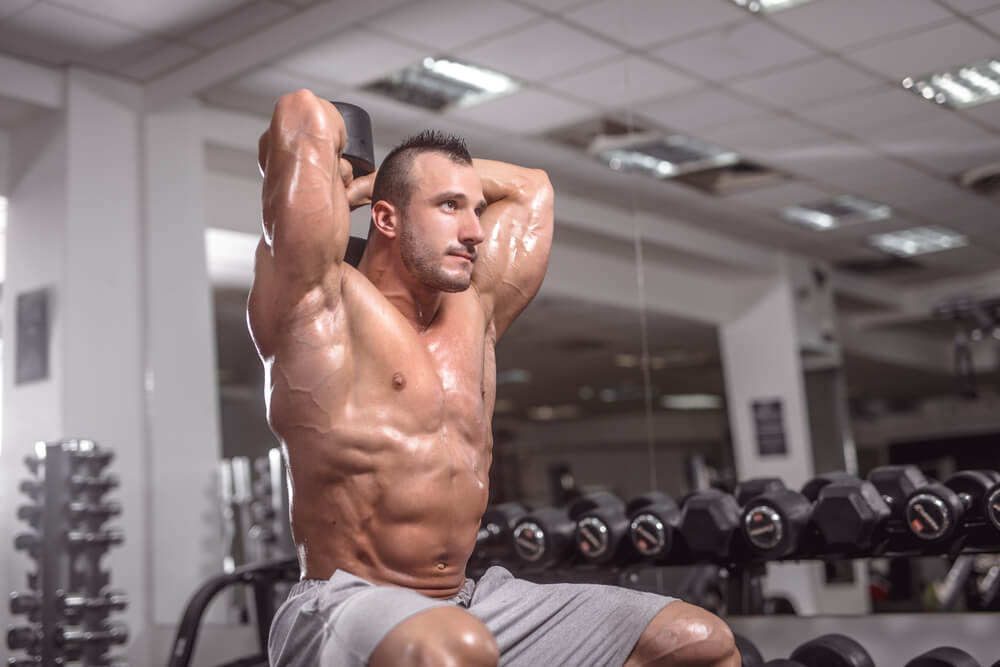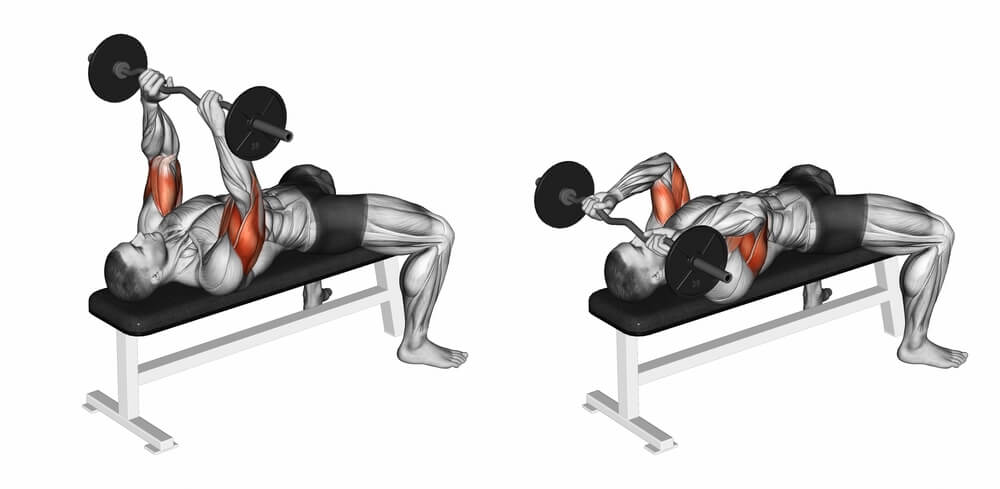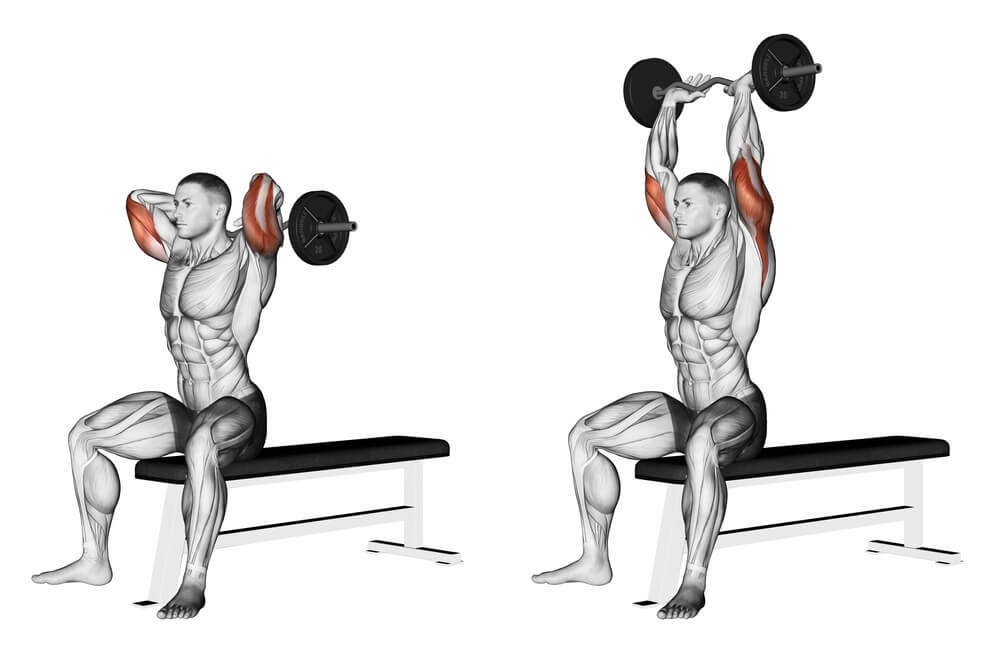Big arms. It is a major goal for so many guys out there. It’s also a major turn-on for plenty of other people you might want to attract as well. So, naturally, if you’re going to the gym to look good, feel good and attract people to your physical appearance, you’re probably working your arms. Problem
Problem is far too many people who hit up the gym to pack on bicep mass under work the opposite side of the arm: the triceps. Triceps not only can make up half of the size of your arm (if not more), but a powerful, strong triceps helps with many of the more popular upper-body exercises (such as the bench press).
There are several great triceps exercises out there (we’re looking at you, skull crusher), but one of the most popular and easiest to perform is the tricep extension.
Do you have questions regarding the benefits of tricep extensions?
Curious as to whether it really is worth adding to your arm workouts, or maybe you’d like to know how the tricep extension hits the back of your arms?
Whatever your questions are, we’ve got all of it covered (and then some).
A Closer Look at the Triceps
Before we look at all the potential benefits of tricep extensions, we need to have a better understanding as to what makes up the tricep muscles.
If you stretch out your arm (you may need to look at it in a mirror), you’ll notice the back of your arm creates an almost horseshoe look, starting at the elbow. The muscles creating this horseshoe look is, in fact, your triceps. Your triceps are made up of three different muscles, also known as heads. Each head is worked in a slightly different way and makes up a different part of the horseshoe.
Each head is worked in a slightly different way and makes up a different part of the horseshoe.
The longest tricep head is known as the lateral head.
This head runs from the elbow up to just under the shoulder. The smallest head is the medial head, which is on the opposite side of the horseshoe as the lateral head. The final head in the tricep is the long head. The long head makes up the top portion of the muscle group (both lateral and medial head connect to the long head). This muscle is right under your shoulder delt muscles.
What is the Tricep Extension?
In reality, the tricep extension should probably be called the triceps extension.
This is because, based on the movement of the weight, you elongate all three of the tricep heads.
You will work the lateral and medial heads a bit more than the long head, although the exact amount of tension placed on each head (and the amount of work each must perform) depends on a bit on how you hold your elbows during the lift. The kind of weight method you use to perform the tricep extension also plays a bit of an impact on this kind of exercise (we’ll get into different equipment options in a little bit).
In order to perform the traditional tricep extension, you’ll hold a single weight above and behind your head.
Keeping your elbows in, you lower the weight until you have about 90-degree bend in the elbow. You will then raise the weight back up to the original position and hold.
This is one set and the basis of the tricep extension.
How to Perform the Tricep Extension?
The traditional tricep extension is performed by standing with your back straight and your feet slightly in closer than shoulder length apart.
Take a single dumbbell and hold it above and behind your head. Place the palm of both hands under the top plate on the dumbbell for a better grip. This way, you don’t need to squeeze the weight or place tension on your hands and wrists. You’ll want to lower the weight slowly. As you do this, make sure to keep your elbows as close to your head as possible.
If you don’t watch this, your elbows will start to flare out. If this ends up happening you’ll not only begin working more of your back than triceps, but you also open yourself up for potential elbow injury as the additional strain is placed on this area of the body as well.
When you lower the weight, you’ll reach a 90-degree bend in your elbows. You can hold it here, or you can allow the weight to lower down a few degrees lower. Realistically, the lower you allow the weight to move the greater the stretch and tear on your triceps, which is what you want for maximum results.
This also forces your muscles to engage more as you push the weight back up.
When you reach a point where you are not able to lower the weight any further (all while making sure you keep your elbows in close to your body), hold it for a moment, then push the weight up. As is the case when lowering the weight down, it is very important for you to keep your elbows in. Pushing the weight up is when you open yourself up for an elbow injury if you do not perform the lift correctly.
So always focus on posture with this move.
It is one of the most important elements to performing a successful tricep extension (ExRx, 2017).
Equipment Options
Ideally, you’ll have dumbbells to work with.
However, if you have an interchangeable dumbbell with a clamp securing the weights in place, you may not feel comfortable holding onto the dumbbell under the top plate, you may want to look at one of these other equipment options. You will achieve a similar muscular engagement if you take advantage of these other equipment options (for the most part).
The closest alternative weight option is to use a kettlebell.
With this option, you’ll have an actual handle on the weight, which may be more comfortable to you. The move is exactly the same with the kettlebell, so you shouldn’t have an issue moving from one weight style to the next.
Another common tricep extension is with the EZ bar (the straight bar that looks like it could be used for a single-handed free weight) on a cable machine. With the bar connected to the top attachment on the tricep extension (you may need to do a bit of height adjusting with this), hold onto the bar in a similar location as you would the dumbbell.
It will be above and slightly behind your head. Have the back of your hands facing the same direction as you (so palms facing behind you) and slowly pull the weight down as far as you can (again, keeping your elbows in). You may actually find this to be a bit more comfortable to do as you do not have an awkward weight lingering behind your neck and back.
The thing about the cable machine is you do need to be conscious of how you allow the weight to lift back up.
Far too many people allow the cable to assist them (it’s hard not to allow the cable to assist in this, as you’ll essentially be fighting gravity). The cable will want to return to its starting position, so it will likely aid you in the back-half of the lift. The thing is, raising the weight backup is a good workout on the inner head of your bicep. If you allow the cable machine to assist, you’ll miss out on an excellent secondary bicep exercise.
Alright, so let’s say you’re on the go a good amount of the time and just don’t have access to a gym on a regular basis.
If that sounds like you, the best way to still squeeze in a resistant workout is to invest in some resistant bands.
Resistant bands are great really anywhere.
Even if you have a home gym, you should pick up some resistant bands as these do an excellent job at replicating what a cable machine does. When using resistant bands though you’ll perform the move in the opposite way (if your gym’s cable machine doesn’t have an elevated attachment hook you’ll perform the lift this way as well, although you’ll use a cable rope to perform what is called an overhead triceps extension).
Place your heels in the middle of the resistant band, then take hold of the grips with each hand. Position your hands so it is as if you’re in the bottom point of the lift (with your elbows at around a 90-degree angle behind your head).
If this feels a bit awkward with the band under your heels, find something heavy you place the band under (such as the leg of a sofa or desk in the hotel room).
From the reversed starting position, lift the resistance band up until your arms are nearly straight above your head (the normal starting position).
Slowly allow your arms to return to the beginning. The resistance band is going to want to snap back to the ground. Fight this by going slowly. This is really where your triceps are hit the most when using the resistance bands.
Benefits of the Tricep Extension
Let’s face it.
You probably don’t exercise the triceps as often as you should.
Or, at least, you don’t directly target the triceps as often as you should. Perhaps you touch on the triceps from time to time as the second half of a bicep exercise, or as you lower weight during a bench press.
However, if you’re like many people at the gym, you just don’t do enough for the triceps (it’s the same with the back and trap area).
People like to work out what they can see, which is why the biceps and chest receive the bulk of the attention. The tricep extension directly targets all three heads of the tricep, which is what makes it such a great exercise.
If you’re curious as to exactly what areas of the triceps you’ll feel the workout the most in, you can identify the muscles without actually using any weight.
Take one arm and lower it down into the downward position of the exercise. Now, feel around the horseshoe of the tricep. You’ll notice the area closest to the elbow is what feels the hardest. Keep your hand on the muscles and lift the arm up (put some make-believe tension as if you’re lifting heavy air here to get the full effect in the triceps muscles).
You’ll feel the exterior tricep head begins to harden and tens up initially.
The other tricep heads are then engaged as your arm lifts higher up.
You can already tell how the tricep will be affected even before you move forward with the lift.
Conclusion
Just about everyone who hits up the gym wants to work on their upper body. You can always tell what day is leg day by the few number of patrons are at the gym.
But hey, working only the upper body is better than working none of the body. Regardless, when working your arms, you need to hit not only the biceps but the triceps as well. Even though most core upper body workouts do engage the triceps to some extent, you need to target the triceps individually in order to isolate the muscles and really tear into the fiber. The beauty of the arms is you can build these up rather quickly (which is why you’ll see guys walking around with Popeye-sized arms and nothing in the chest).
By taking advantage of an exercise such as the tricep extension, you’ll see a drastic improvement not only in the size of your arms (as long as you keep up with your nutrition and protein intake), but you’ll also see an improvement in your other upper body lifts as well.
As the only major muscles on the back side of your arm, the triceps are important and need to be trained.
So stop under training your triceps and add in this extension to your workout today!
-Terry Asher
Terry Asher
Latest posts by Terry Asher (see all)
- Better Family – Product Review Liquid Daily 2 oz - Dec 16, 2024
- Post-Workout Recovery: The Key to Optimal Performance - Nov 25, 2024
- Pre-Workout Supplements – Everything You Need To Know - Nov 18, 2024














Wow, No doubt i love so much to do triceps exercise and it is quite easy as well. Thanks for the post.
Wow!
Full of information. Thank you for sharing this article with us.
It really motivates me to add some more workouts to my routine plan.
Keep posting.
Thank you so much for your blog. I’ve been following your tips on what types of workouts to perform and you’ve improved my understanding of fitness goals immensely!
[…] exercise provides a different stimulus to our body. For instance, a Triceps Rope Pressdown, and a Triceps Rope Overhead Extension stress the triceps in different ways. The Pressdown trains the triceps more in the shortened […]